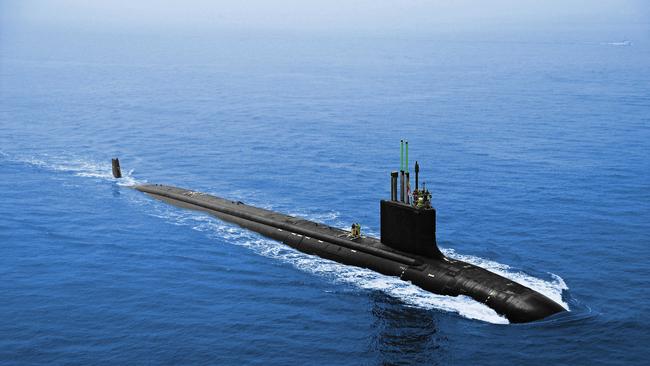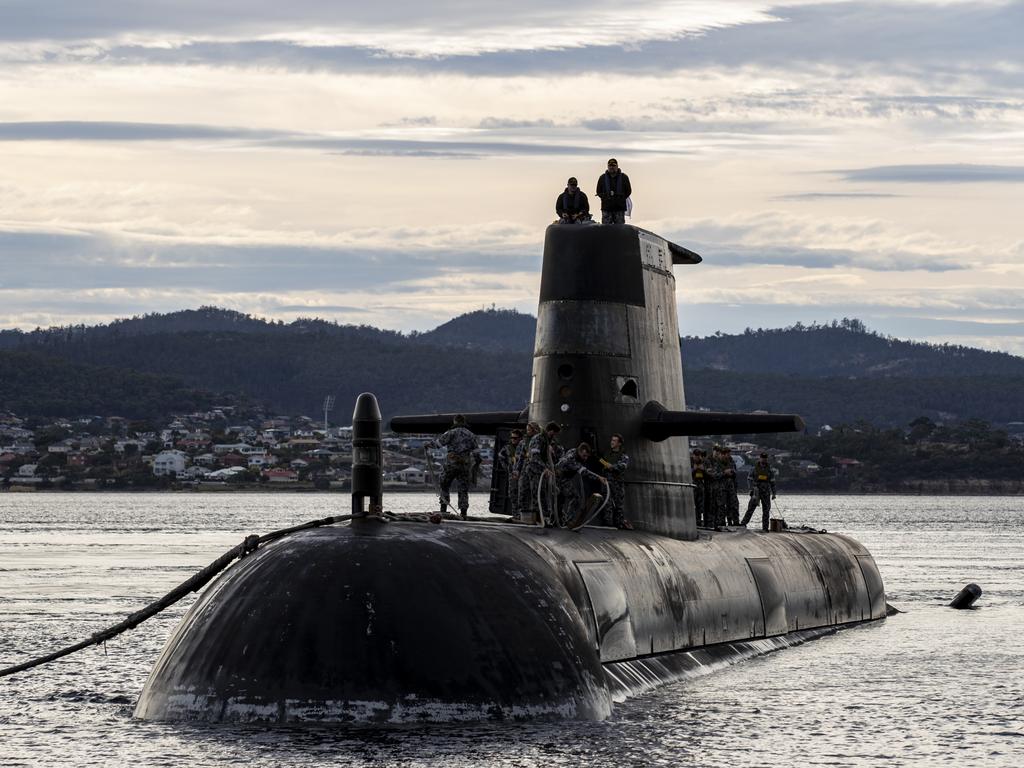Nuclear submarines could prove to be a paralysing fantasy
We are living in a fool’s paradise which can yield only bitter disappointment and further decades of delay. The Morrison government, like its predecessors, shows it hasn’t a clue.

As the government testimony unintentionally makes clear, the real weight of the AUKUS announcements has been to abolish Australia’s future submarine program and to effectively abolish, or at least radically diminish, our naval shipbuilding industry.
That this has effectively passed without comment is a sign of the shallow, debased nature of our national debate.
Our politics now deals overwhelmingly in symbols, the more distant the better
Australian defence policy now resembles a speculative mining stock at the height of a minerals boom. Whatever you do, don’t drill, was the speculator’s mantra. As soon as you drill, you destroy share value.
The same is true of our defence capabilities. While they are pure speculation – announcements with no results in the physical universe – they are soaringly popular, hailed as historic, and evaluated at their exaggerated potential.
As soon as there is an attempt to produce anything concrete, it turns to dust – politically and, often enough, almost literally.
Vice Admiral Michael Noonan, the Chief of Navy, gave critical testimony before a Senate committee on October 15. Under probing questioning from Labor senator Kimberley Kitching and independent Rex Patrick, he revealed that the navy fully expected that we could be operating the Collins-class submarines into the 2050s and beyond.
Not only that, the prospects of the nuclear-powered boats arriving is so distant that the navy is already considering not one Life of Type Extension for the Collins boats, but two.
This is truly grotesque. It makes a mockery of the diplomatic achievements of AUKUS and reveals that, in substance, the Morrison government has been just as irresponsible in providing for defence as all the governments have before it since John Howard.

We operate now six conventional Collins-class submarines. They were commissioned by Bob Hawke in the 1980s and built in the 1990s. Submarines are a potent military force. They are asymmetric; they inflict serious damage at relatively low cost. Because the enemy does not know where they are, they pose questions to any potential aggressor in a way other systems do not.
Nonetheless, they are not remotely the be all and end all of military capability. The age of the submarine will probably one day come to an end as their stealth declines. But for the moment, they are the apex predators of the sea. But the ocean is unforgiving, and you cannot keep subs operating forever.
The Collins boats were scheduled to begin retiring in the mid 2020s. Because no government has taken one single decision that has stuck for more than five minutes on replacing the Collins, all six boats will now undergo a full Life of Type Extension. This is like a major rebuild. The sub is cut in half and all the internal systems updated. The process takes two years. The first, HMAS Farncomb, begins its LOTE in 2026. It will be out of service until 2028. The LOTE notionally gives it 10 more years of life.
But only under the most wildly optimistic fantasy will an Australian nuclear-powered sub arrive by 2038, so, Kitching asked Noonan, does not that mean there will be a capability gap? No, said Noonan, we can keep them trundling on. So, asked an incredulous Kitching, the Collins could be serving in the whole decade 2040 to 2050?
“Potentially, yes,” Noonan replied.
Patrick, intrigued by this, sought further detail. Noonan finally conceded to Patrick: “The LOTE will give us 10 years, as you’ve correctly indicated, but I am not writing off the opportunity to conduct a further LOTE”.
What? This would means a Collins submarine that was commissioned in the 1980s, built in the 1990s and meant to retire in the 2020s, would be sawn in half and stuck back together and operate until the late 2030s, and then be sawn in half a second time and operate until the late 2040s, and presumably, if necessary, be sawn in half a third time and operate into the 2050s.
This is what the AUKUS agreement has yielded so far – a cast-iron guarantee that, if we follow current plans, we will have the oldest, most decrepit submarines we can possibly imagine as the front line of our defence for decades to come.
The costs and dangers of keeping the Collins going so long are extreme. The first LOTE will cost billions of dollars, almost as much as a new submarine.
But then there is the question of safety. The Collins will in their later decades be much older than was the Indonesian submarine, the KRI Nanggala-402, which sank to the ocean floor off the coast of Bali with the loss of all crew earlier this year.
The B-52 bomber is an example of a platform which has kept going for decades with endless upgrades. But the air is different from the sea. Even in the air, sometimes safety becomes impossible. The F1 11 fighter bombers had to be grounded all at once and all of a sudden because of safety issues.
As Australia struggles to keep its Collins fleet operational in the 2040s and 50s, there is a real chance that at some point the boats’ safety cannot be guaranteed and then they are all taken out of the water at once, and we have nothing.
But might we not get the nuclear subs earlier than that?
The prospects look increasingly dismal. Although we have Americans on our subs already, and have had Australians on US subs, as Noonan made clear, no Australian submariner has had access to “the back of the boat”, where the nuclear reactor drives the submarine.
Admiral Michael Gilday, the chief of US Naval Operations, has said he thinks any Australian nuclear-propelled submarine is “decades away”. The good admiral is hardly likely to diss an ally. His words probably represent fairly extreme optimism. Taken at face value, they mean the first nuclear-propelled sub doesn’t arrive until the early 2040s at best.
But it takes a navy years to learn how to operate a nuclear sub. And it is inconceivable we would get subsequent nuclear-powered subs faster than one every three years. So we don’t get our fleet of eight until half way through the 2060s, when the dear old Collins boats will be presumably going through fourth and fifth facelifts.
Am I being too tough here?
During the week, the government confirmed, via an answer in parliament from Defence Industry Minister Melissa Price, that it intends to build the nuclear subs in Adelaide. No one believes this is credible. If we persist with the idea that, with zero nuclear experience of any kind, and with no relevant submarine-building experience of any kind for decades, we can start from scratch and build a nuclear submarine in Adelaide.
We are living in a fool’s paradise which can yield only bitter disappointment and further decades of delay.
What about leasing? The US is retiring its Los Angeles-class nuclear subs as it builds about two Virginia-class subs per year. There are 28 LA-class boats still in service. They are already 25 to 36 years old. The US has decided to take the five youngest of the LA boats and refurbish them. This involves a full workover, similar to the LOTE. It also involves refuelling the reactors. That will take three years and cost about $720m.
The US is behind China in the number of submarines it has, the number of submarines it can deploy to the Pacific, and in various metrics of maritime conflict. It is extremely unlikely to take a nuclear boat from its battle line to give to Australia which has no experience, no record, and no capability in operating it.
So the absolute best thing we could get might be an extremely elderly LA-class boat which we wouldn’t know how to operate. This might be useful for training. But, in fact, many key points of technology will be quite different between an LA-class and a Virginia, which presumably is the type of boat we would like to operate eventually. Furthermore, the Americans by then would have got out of the business of managing and supporting LA-class boats.
The record of navies that buy second-hand submarines is pretty woeful. The Canadians thought they’d do subs on the cheap and bought four second-hand British conventional boats. It was a disaster. In 2019, the Canadian submarine fleet did not provide one single day at sea.
Leasing from the Brits would be even more difficult. The Brits still have some Trafalgar-class subs in service as they move to the Astutes. The Brits are light years ahead of us in nuclear technology and even they have found the Astutes very difficult to bring to full service. If we leased a Trafalgar boat, it would again necessarily be very old. And it has different reactor technology from the Astute.
So we would be operating and training on something different from the boat we would want to acquire, and the Brits themselves would have moved out of the business of supporting such boats.
There was another, truly terrifying sentence in Noonan’s Senate testimony. Please, Patrick implored, promise me that we are not going to create some unique Australian design here – that we will get, simply, either a Virginia or an Astute?
Noonan’s reply: “Certainly, Senator, my expectation is that the work that Jonathan Meade’s task force will be leading will be in that space of considering the best technologies and the best co-operation that the US and UK can offer, with a view to a submarine from that DNA that this meets our requirements.”
A submarine from that DNA? Yikes! Good Godfrey! Is there truly no end to Australian madness? Another unique Australian naval project, another hundred years of solitude, another taxidermist’s nightmare splicing features from all sorts of incompatible bodies into one Frankenstein’s monster of which, unlike the original, no one will ever say: “It’s alive!”
There are two broad ways that the nuclear-propelled submarine from AUKUS can proceed. The most rational and best would be for whoever is prime minister after the next election to say yes, they are proceeding with a nuclear-propelled sub – but it will be built in the US when they can fit us into their schedule and we can operate it. In the meantime, Adelaide will build additional Collins-class boats, not even the Son of Collins, not an evolved design, just the Collins with all the upgrades the LOTE will confer. We might build six of these, avoiding the effective death of the naval shipbuilding industry which seems likely, and continuing to have a modest conventional submarine capability, which is a lot better than nothing. We cannot get to this rational decision as long as we persist with the Adelaide nuke-build fantasy. And one day the nukes will come along, built in America.
The other way this project proceeds is the characteristic Australian way. Nothing at all happens for years and years and years. But we talk about it relentlessly. We finally manage to start on some modest facilities in Adelaide. And it all ends in tears down the track.
Meanwhile, one thing we emphatically are not doing is responding to the urgent maritime national security challenge we face. Psychologically, we are the same as the Afghan government which fell to the Taliban. We just assume the Americans will always take care of business for us.
We are more fully strategic clients than we have ever been. More hopeless. More fatuous. More incapable of taking a single military action in our own interest.
Nuclear subs may arrive at the very same time as we hit net-zero carbon emissions, sometime the other side of never.








Crucial testimony to Senate committees, plus parliamentary answers to questions, have gone substantially unreported but tell us one terrible truth – Australia is going to be completely unprepared militarily for any maritime security challenge in the next two decades, without any upgraded submarine capability and more completely reliant on the US than ever before.